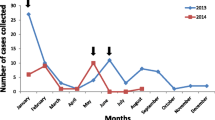Abstract
Background
Although aseptic meningitis associated with echovirus type 30 has emerged as a global public health concern, no data have been reported on Children’s immune status against echovirus type 30. The current study aimed to investigate the seropositivity among Korean children for antibodies against echovirus 30.
Methods
Two hundred and fifty residual serum samples were collected at St. Paul’s Hospital. Individuals were categorized by age into four groups: group 1 (3 months–2 years), group 2 (3–6 years), group 3 (7–10 years) and group 4 (11–15 years). Neutralizing antibodies against echovirus 30 were measured.
Results
Seroprotective neutralizing antibodies against echovirus 30 were detected in 129 (49%) individuals. Seropositivity rates were 23%, 48%, 55% and 73% in groups 1–4, respectively. For antibody titers, 1:256–1:512 was the highest neutralizing antibody titer range in group 2, while 1:1024–1:2048 in group 3 and 4. Among the seropositive individuals in group 3 and 4, 6% and 12% had neutralizing antibody titers of 1:2048, respectively.
Conclusions
The seropositivity rate increased significantly with age. The distribution of neutralizing antibody titers varied by age group, and higher ranges of neutralizing antibody titers were observed in higher age groups. These findings suggest high susceptibility to echovirus 30 infection in children younger than 2 years old. Echovirus 30 infection in childhood may have contributed to increased neutralizing antibody titers with age.
Similar content being viewed by others
References
Harvala H, Simmonds P. Human parechoviruses: biology, epidemiology and clinical significance. J Clin Virol 2009;45:1–9.
Esposito S, Rahamat-Langendoen J, Ascolese B, Senatore L, Castellazzi L, Niesters HG. Pediatric parechovirus infections. J Clin Virol 2014;60:84–89.
Wolthers KC, Benschop KS, Schinkel J, Molenkamp R, Bergevoet RM, Spijkerman IJ, et al. Human parechoviruses as an important viral cause of sepsislike illness and meningitis in young children. Clin Infect Dis 2008;47:358–363.
Kumar A, Shukla D, Kumar R, Idris MZ, Jauhari P, Srivastava S, et al. Molecular identification of enteroviruses associated with aseptic meningitis in children from India. Arch Virol 2013;158:211–215.
Mladenova Z, Buttinelli G, Dikova A, Stoyanova A, Troyancheva M, Komitova R, et al. Aseptic meningitis outbreak caused by echovirus 30 in two regions in Bulgaria, May-August 2012. Epidemiol Infect 2014;142:2159–2165.
Croker C, Civen R, Keough K, Ngo V, Marutani A, Schwartz B, et al. Aseptic meningitis outbreak associated with echovirus 30 among high school football players-Los Angeles County, California, 2014. MMWR Morb Mortal Wkly Rep 2015;63:1228.
Mantadakis E, Pogka V, Voulgari-Kokota A, Tsouvala E, Emmanouil M, Kremastinou J, et al. Echovirus 30 outbreak associated with a high meningitis attack rate in Thrace, Greece. Pediatr Infect Dis J 2013;32:914–916.
Chomel JJ, Antona D, Thouvenot D, Lina B. Three ECHOvirus serotypes responsible for outbreak of aseptic meningitis in Rhône-Alpes region, France. Eur J Clin Microbiol Infect Dis 2003;22:191–193.
Milia MG, Cerutti F, Gregori G, Burdino E, Allice T, Ruggiero T, et al. Recent outbreak of aseptic meningitis in Italy due to Echovirus 30 and phylogenetic relationship with other European circulating strains. J Clin Virol 2013;58:579–583.
dos Santos GP, da Costa EV, Tavares FN, da Costa LJ, da Silva EE. Genetic diversity of Echovirus 30 involved in aseptic meningitis cases in Brazil (1998-2008). J Med Virol 2011;83:2164–2171.
Park IS, Lee HS, Choi SH, Kim HJ, Hwang SY, Cheon DS, et al. Epidemiology and clinical characteristics of enterovirus infections in children: a single center analysis from 2006 to 2010. Korean J Pediatr Infect Dis 2013;20:81–88. [In Korean]
Hyeon JY, Hwang S, Kim H, Song J, Ahn J, Kang B, et al. Accuracy of diagnostic methods and surveillance sensitivity for human enterovirus, South Korea, 1999-2011. Emerg Infect Dis 2013;19:1268–1275.
Lee YP, Hyun JY, Korea Centers for Disease Control and Prevention (KCDC). Laboratory-based enterovirus surveillancein in Korea, 2012-2013. PHWR Public Health Wkly Rep 2014;7:421–424. [In Korean]
Xiao H, Guan D, Chen R, Chen P, Monagin C, Li W, et al. Molecular characterization of echovirus 30-associated outbreak of aseptic meningitis in Guangdong in 2012. Virol J 2013;10:263.
Juhela S, Hyöty H, Lönnrot M, Roivainen M, Simell O, Ilonen J. Enterovirus infections and enterovirus specific T-cell responses in infancy. J Med Virol 1998;54:226–232.
Rabenau H, Weber B. Evaluation of a new automated microneutralization assay for the quantitative detection of neutralizing antibodies against enteroviruses. Zentralbl Bakteriol 1994;280:534–539.
Joki-Korpela P, Hyypiä T. Diagnosis and epidemiology of echovirus 22 infections. Clin Infect Dis 1998;27:129–136.
Weber B, Rabenau H, Cinatl J, Maass G, Doerr HW. Quantitative detection of neutralizing antibodies against polioviruses and non-polio enteroviruses (NPEV) using an automated microneutralization assay: a seroepidemiologic survey. Zentralbl Bakteriol 1994;280:540–549.
Teng S, Wei Y, Zhao SY, Lin XY, Shao QM, Wang J. Intestinal detoxification time of hand-foot-and-mouth disease in children with EV71 infection and the related factors. World J Pediatr 2015;11:380–385.
Author information
Authors and Affiliations
Corresponding author
Rights and permissions
About this article
Cite this article
Lee, J.Y., Seo, Y., Choi, U.Y. et al. Seroepidemiology of echovirus 30 in Korean children. World J Pediatr 13, 611–614 (2017). https://doi.org/10.1007/s12519-017-0058-x
Received:
Accepted:
Published:
Issue Date:
DOI: https://doi.org/10.1007/s12519-017-0058-x




